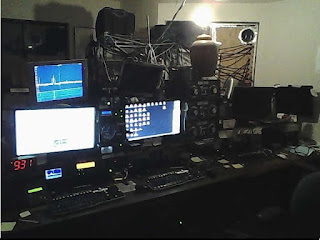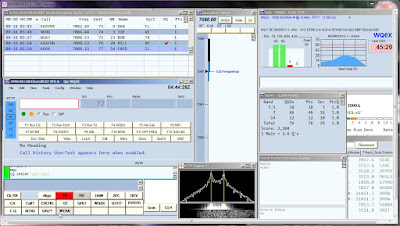 |
| A FRUSTRATED WQ6X ponders the QRN problem. |
at least the software had been recently updated and configured.
Typical for an NA contest, the strategy
is to begin on the highest band providing an opening (in this case 20 meters), working downward in frequency as
the evening progresses.
For this event, 10 & 15 were DOA and 20 was already on the way out by 00:15z; only one station heard me and was quickly swallowed up by the noise.
By 00:30, I got the message and moved on down to 40 meters, where the K-Index=4 QRN was worse than on 20.
The 4 hours encompassing the SPRINT were spent frantically diddling the Yaesu's e-DSP knobs,
the QF-1A filters and even a switch in antenna configuration, with frustrating results. All 4 QSOs
made occurred on 40 meters using the onsite CHA-250 vertical. Configuring the 8JK Sloper as a receive antenna reduced the receive noise, allowing R-3 level copy of signals, but w/the side-effect
of reducing overall signal strength; which is where the PEAK setting of the QF-1A filter comes through, shaping the audio for improved aural consumption.
 |
| FT-1000mp setup during NA SPRINT |
After the contest, I unwound by tinkering with a recently acquired MFJ-1272 TNC interface for $8.
By use of some clever Y-audio connections and splicing audio connectors onto the TNC cable
(after chopping off [literally] the TNC DiN connector).
External equipment testing (on 3587.87) after the SPRINT GiG not only confirmed the validity of the transmit cabling, it gave the FT-1000mp a FULL DUTY Workout for over 20 continuous minutes of send looping "Tasting 1,2,3" messages. Another transmit test on Sunday confirmed the 100-watt FULL DUTY capabilities; just in time for the CQ W.W. RTTY Contest.
Originally, I bought this Yaesu FT-1000mp from N6VR, largely in part because of his award-winning,
proven contest use of the radio, running it SO2-R with a nearly identical FT-1000mp; which KB7V eventually purchased. Ray (typical of many contesters) sold off a pair of 1000mp's, replacing
them with a pair of Elecraft K3's. Ergonomically, I prefer the Yaesu over the Elecraft any day.
Shortly after setting the radio up @ W7AYT's QTH, I discovered the transceiver could run RTTY
@ 100 watts (FULL DUTY) with only a barely perceptible cabinet warmth felt over the PA section.
The [barely audible] cooling fan on the left side of the transceiver evidently does an EXCELLENT
job of keeping the insides of the equipment incredibly cool.
 |
| FT-1000mp configuration after NA SPRINT |
752-B were contributing very little towards QRM/QRN reduction. These units have been recalled
to the "WQ6X equipment evaluation lab" for further consideration and re-evaluation.
For now, that leaves a lone QF-1A (for Main-RX audio) and a JPS NIR-12 for Sub-RX audio.
At least both receivers will have DNF (Digital Notch Filtering) along with DNR (Digital Noise Reduction) and audio bandwidth shaping. During my next visit to W7AYT, I will bring in
a 2nd QF-1A for insertion into the Sub-RX audio line (BE-4 the NIR-12 DSP).
This will create a variable near equivalent (altho analog) to the eDSP contour
control in the 1000mp's Main-RX.
 |
| KK6NON running SO2-R |
QSO party (MEQP). Reading the after contest soapbox comments, it would seem that the SF
bay area was hardly the only area in North America experiencing the problem with weak signals
and near S-9 noise levels.
Then again, some top notch operators did quite well, in spite of the poor condx. KK6NON did an OUTSTANDING SO2-R run as NX6T. While I HEARD NX6T on both 40 and 80, the propagation
was all one way at W7AYT; mostly receive only, except for Oregon and a pipeline to IN & OH.
 |
| N X 6 T A f t e r H o u r s |
was given a good workout. If I could say the same thing about the WQ6X 8JK Sloper, then all will
be good.
Did YOU work the NA SSB SPRINT contest?
Is NX6T in YOUR log?











